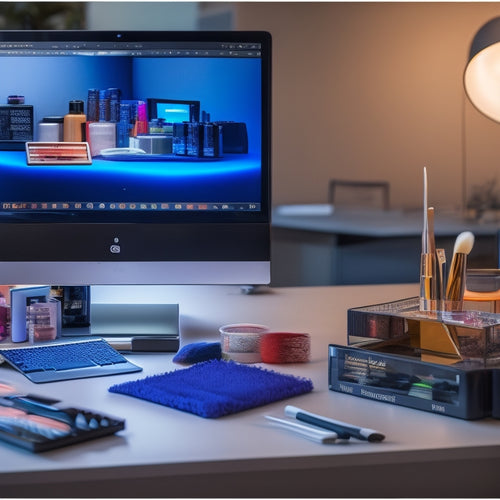
Legal Safeguards: Makeup Artist Liability Release Form
Share
A well-crafted liability release form is crucial for makeup artists to protect themselves from potential legal claims and financial losses. This legal safeguard clearly outlines the scope of services, client responsibilities, and limitations of liability, ensuring a mutual understanding between parties. By establishing clear boundaries, makeup artists can shield their business from legal repercussions, prevent financial losses, and manage client expectations effectively. A comprehensive liability release form protects makeup artists from unforeseen circumstances, allowing them to focus on their craft. Understanding the intricacies of this vital document is essential for a secure and prosperous business, and exploring its essential elements can provide further insight.
Key Takeaways
• A liability release form protects makeup artists from legal claims and clarifies service responsibilities, establishing a mutual understanding with clients.
• The form outlines client expectations, contractual obligations, and limits liability for damages or injuries, minimizing the risk of disputes.
• Clear definitions of client responsibilities and explicit liability limitations safeguard the business from legal repercussions and financial losses.
• A well-structured liability release form ensures effective risk management, preventing disputes and protecting business interests and reputation.
• By establishing clear boundaries and managing client expectations, the form provides a strong foundation for a successful makeup artistry business.
Understanding Liability Release Forms
A liability release form is an essential document that serves as a safeguard for makeup artists, protecting them from potential legal claims and ensuring a clear understanding of the responsibilities and risks involved in providing makeup services. This document outlines client expectations and contractual obligations, establishing a mutual understanding between the makeup artist and the client.
Essential Elements of Protection
To guarantee thorough protection, a well-crafted liability release form must incorporate several key elements that safeguard the interests of both the makeup artist and the client. These essential elements include clear definitions of client responsibilities, outlining the duties and obligations of the client during and after the makeup service.
Additionally, liability limitations must be explicitly stated, specifying the circumstances under which the makeup artist may be held liable for damages or injuries. By including these elements, the liability release form ensures that both parties are aware of their roles and responsibilities, thereby minimizing the risk of disputes and legal claims.
A detailed and well-drafted liability release form provides a solid foundation for a successful and protected business.
Safeguarding Your Business
By implementing a thorough liability release form, makeup artists can effectively shield their business from potential legal repercussions and financial losses. This crucial document helps manage client expectations by clearly outlining the scope of services, risks involved, and boundaries of liability. Effective risk management is key to safeguarding a business, and a well-structured liability release form is essential in achieving this goal.
| Risk Management Strategy | Benefits |
| Managing client expectations | Clears up misconceptions, prevents disputes |
| Limiting liability exposure | Protects business from financial losses |
| Establishing clear boundaries | Ensures clarity on services provided |
Frequently Asked Questions
Can I Customize the Liability Release Form to Fit My Specific Business Needs?
Yes, you can customize the liability release form to fit your specific business needs, ensuring compliance with legal requirements, while incorporating essential clauses and customization options to safeguard your professional interests.
How Often Should I Update My Liability Release Form to Stay Current?
To guarantee continued protection, it is essential to review and update your liability release form regularly, ideally every 6-12 months, to reflect changes in legal requirements, industry developments, and shifting client expectations.
What Happens if a Client Refuses to Sign the Liability Release Form?
'A thousand potential disputes can be avoided when a client refuses to sign a liability release form, as it's vital to respect their rights while being aware of the legal consequences, such as potential lawsuits or disputes, that may arise from their refusal.'
Can I Use a Generic Liability Release Form or Do I Need a Lawyer?
While DIY forms may seem convenient, they can pose risks. It's recommended to consult legal advice to guarantee a customized liability release form that meets specific business needs, rather than incurring the expense of potential legal issues down the line.
Are Liability Release Forms Required for All Types of Makeup Services?
While liability release forms are essential for high-risk makeup services like special effects or permanent makeup, they may not be legally required for all types of services, but a makeup artist should still consider them to address liability concerns and guarantee client protection.
Related Posts
-

Why Pro Dance Makeup Artists Need Online Training
As a pro dance makeup artist, you know that keeping up with industry trends, techniques, and tools is crucial for del...
-

3 Ways to Monetize Your Dance Expertise Online
You can harness your dance expertise into a lucrative online business by leveraging your skills in three key ways. Yo...
-

Issuu's Dynamic Flipbook Creation: Engage & Share
Issuu's dynamic flipbook creation platform revolutionizes digital content creation, offering an intuitive and seamles...


